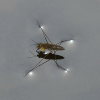water strider
A mythic being who helped the Zunis in their search for the Middle Place, or what is now understood as Zuni Pueblo. Water striders are graceful-looking insects that, when they extend their long legs, can walk on water. Because the Zuni live in a high, arid desert environment, water and those beings associated with it, such as water striders and dragonflies, play roles having cultural and spiritual significance.












